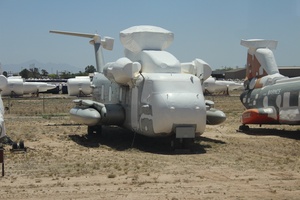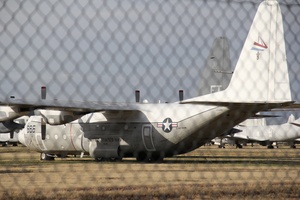Residing within the Davis-Monthan Air Force Base in Tucson, Arizona is the largest military aircraft boneyard in the world. Located five miles southeast of downtown Tucson, the boneyard fills 2,600-acre of the 3,300- acre expanse of the field, and as of 2019 officially holds over 3,280 aircraft and 13 aerospace vehicles from the United States Air Force, Army, Coast Guard, Navy, Marine Corps, and National Aeronautics and Space Administration (NASA). Users interested in the Davis-Monthan Air Force Base, not the boneyard, should click here.
The boneyard is located north of Valencia Road and south of Escalante Road, in between Wilmot Road and Kolb Road. This is near the Davis-Monthan Air Force Base, which is located at 2720 S. Craycroft Rd.
The airfield was established in 1919, and the Davis-Monthan Air Force Base was established six years later. However, the aircraft started being transported to the boneyard, whose official title is 309th Aerospace Maintenance and Regeneration Group (AMARG), as far back as 1946. The facility has housed and serviced almost every single famous American aircraft ranging from the B-29 “Enola Gay” to the SR-71 Blackbird as the largest historic boneyard in the world, as well as remaining as the last operational American Boneyard
WHY TUCSON?
 (Photo Credit: Phil on Flickr shared per Creative Commons License)
(Photo Credit: Phil on Flickr shared per Creative Commons License)
Tucson’s weather plays a large role in the preservation of the aircraft. Tucson offers low humidity levels of the 10%-20% range, a relatively high altitude of 2,550 feet above sea level, and an average of only 11 inches of rainfall annually. The environment serves as an ideal setting for the dry storage for the preservation and maintenance of military equipment with little chance of airframes rusting and not in danger of suffering from sandstorms local to Arizona’s capital, Phoenix. Because of the minuscule risk of any natural disasters in the city, the aircraft in the boneyard are well preserved and could potentially be reused in the future for foreign sales, demilitarization, or rearmament in case of renewed conflict.
Another important contributing factor in the decision to move aircraft into Tucson is the city’s hard alkaline soil, which contains sodium, calcium, and magnesium. The hard soil creates reduced risk of the resident aircraft that in many cases can be dozens of tons sinking into the ground during the monsoon season. Tucson also offers a high altitude of around 2,550 feet reducing humidity and features a relatively flat terrain reducing the danger of runoff. The surrounding mountains further contribute due to the limiting of heavy winds that often plague desert environments.
Additionally, because Tucson is located in the Sonoran Desert, it’s easy to transport aircraft back and forth without needing to pave any areas due to the hardiness of the terrain. This limits the logistical constraints on the 309th AMARG “Boneyard” and permits further expansion as necessary and has in the past allowed the 309th to house more than 6000 aircraft in 1973, during the winddown of the Vietnam War.
RECEIVING NEW AIRCRAFT
 (Photo Credit: Aeropho.toyo on Flickr shared per Creative Commons License)
(Photo Credit: Aeropho.toyo on Flickr shared per Creative Commons License)
When aircraft are received at the boneyard, they are gifted with the aircraft's documented history. These documents tell of the aircraft’s achievements, contributions, combat logs, and crew logs. More importantly however for the purposes of the 309th, these documents carry specific information which includes the kinds of maintenance it once underwent since its active service in the military.
The vast majority of the aircraft that come into the Boneyard come in and land under their own power. Specifically, it is estimated that 95% of military aircraft that are meant to be transferred into the inventory of the 309th come in under their own often loaded with fuel, explosives, chemical agents, and potentially ammunition and ordinance carried during their tenure as active combat aircraft. In turn, this creates several issues that are cause for concern if not for the specialized equipment and personnel that are part of the 309th’s inventory.
Prior to being stationed in the boneyard, guns, ejection seats, clocks, data plates, and classified hardware are all removed and processed. The aircraft is then washed, which is especially important when dealing with aircraft that have been in tropical locations. If they aren’t washed, they could be subject to corrosive effects in Tucson’s hot climate. In this process, the fuel system is also drained and refilled with lightweight oil, only to be drained once more. Following this, the aircraft is sealed from exposure to any dust, sunlight, or scorching summer temperatures. This can be done with chemicals and sealants such as Spraylat, but simple garbage bags are also utilized as protective measures during short-term processing. From here, the aircraft is ready to be towed and pulled to its designated location in the boneyard.
However, not all aircraft are able to be reused again. Much of the aircraft is maintained in case it is called back into active service, but the boneyard also reclaims the aircraft and sells or recycles certain parts during the reclamation process. Some aircraft are also placed at Davis-Monthan on a temporary basis until they can be shipped to different staging areas across the world.
Specifically, this is done by categorizing the Airframes into four 1000 block categories. Type 1000 refers to aircraft destined for long-term storage, where they will be maintained until they are recalled into active military service. They will be rendered “inviolate” and have a high potential to return to flying status and will remain whole and will be maintained regularly. 2000 Block Aircraft are less fortunate given their reclaimed status, where they will be kept in partial order to act as parts salvage to keep other aircraft in working order. 3000 block aircraft are placed on “flying hold” where they will be kept in near flying condition in short-term, temporary storage where they will be held for transference to another unit, prepared for foreign sale, or reclassification into one of the other three types. Finally, the 4000 block aircraft are deemed as excess to Department of Defense needs, They will be broken down and sold as scrap, ingots, and other recyclable materials.
BONEYARD HISTORY
 Boneyard in 1980 (Photo Credit: fsll2 on Flickr shared per Creative Commons License)
Boneyard in 1980 (Photo Credit: fsll2 on Flickr shared per Creative Commons License)
By May of 1946, over 600 B-29 Superfortresses and 200 C-47 Skytrains were moved to the boneyard. Some of the said aircraft were refurbished and used in the Korean War or sold into civilian service. The majority of others were completely scrapped as their service was rendered obsolete.
By February of 1956, the first Convair B-36 Peacemaker arrived at the boneyard for scrapping. In the end, 384 Peacemakers were scrapped and dismantled, but four were remaining models were saved for preservation in air museums.
At the time, Litchfield Park in Phoenix, Arizona also held an aircraft storage facility as the primary boneyard for the majority of Navy aircraft. By 1965, the facility merged its inventory into Davis-Monthan’s boneyard. The majority of the aircraft was all transported by truck because it was less expensive than attempting to prepare the planes to fly to Tucson after storage, just to preserve them once again.
This was also the year when the boneyard changed its name to Military Aircraft Storage and Disposition Center (MASDC).
In 1964, the last B-47 aircraft left Davis-Monthan, as they needed space for the 50 F-4 Phantom II aircraft. By 1969, the last Air Force B-47 Jet Bomber was retired and scrapped at Davis-Monthan, with the exception of 30 Stratojets that were saved for preservation in air museums. Around this time, ICBM missiles were also introduced to the boneyard as Davis-Monthan became one of the first facilities to house the Titan Missiles, along with 365 B-52 Stratofortress Bombers in the ‘90s.
By 1985, the boneyard underwent a new name, Aerospace Maintenance and Regeneration Center (AMARC), but is now called 309th Aerospace Maintenance and Regeneration Group (AMARG).
In 2013, the final F-4 Phantom was refurbished and performed its last flight in Tucson.
BONEYARD TODAY
Today, Davis-Monthan’s boneyard is the sole aircraft boneyard to hold excess military aircraft for possible reuse and miscellaneous refurbishments. The boneyard has been at work with the reactivation of the dormant fleet of F-4 Phantom IIs, F-16 Fighting Falcons, And F-18 Hornets for use within the military again as autonomous platforms and as aerial targets drones.
Currently, the Boneyard acts as an important part of the Tucson economy as it employs 550 personnel of primarily the civilian sector and an additional 200 private contractors. More importantly, the Boneyard contributes to the tourism of the local Tucson area. Tours of the boneyard are offered to individuals through the Pima Air & Space Museum, which is located on Valencia Road. This guided motor coach tour, occurring Monday through Friday, generally lasts about an hour and a half and provides individuals with the history of the site and aircraft. However, no one is allowed off of the bus during the tour. Baggage checks and valid identification are required before getting on the bus, and security is enforced heavily due to the facility being a part of Davis-Monthan Airforce Base.
For those who want a closer peek at the aircraft, it’s recommended to visit the Pima Air & Space Museum separately, which houses over 300 planes within 80 acres, and allows you to go within inches of the aircraft where visitors can take pictures with icons of aromatic and military aviation and even touch some of the vehicles in the yard.
BONEYARD FUN FACTS
 Filming Transformers 2 (Photo Credit: Movie Chronicles)
Filming Transformers 2 (Photo Credit: Movie Chronicles)
-
Part of the second Transformers movie, Revenge of the Fallen, was filmed at Davis-Monthan’s boneyard. The movie was released in 2009 in place of the Smithsonian.
-
The Pima Air & Space Museum, a privately funded air museum, is the largest of its kind in the world.
-
One of the few survivors of the famous Lockheed SR-71 Blackbird family is housed in Tucson.
-
Mainly set up for the purpose of tours, the boneyard offers “Celebrity Row,” which is a line of iconic aircraft.
-
In 2012, the boneyard held more than 10,000 aircraft parts, which valued at $472 million combined.
Sources:
 (Photo Credit: Aeropho.toyo on Flickr shared per Creative Commons License)
(Photo Credit: Aeropho.toyo on Flickr shared per Creative Commons License)
Air Space Mag. http://www.airspacemag.com/daily-planet/tour-boneyard-180952460/
Airplane Boneyards. http://www.airplaneboneyards.com/davis-monthan-afb-amarg-airplane-boneyard.htm
Airplane Mart. https://www.youtube.com/watch?v=AfTNxbVnKJQ
AMARC Experience. http://www.amarcexperience.com/ui/index.php?option=com_content&view=article&id=2&Itemid=213
CGM Findings. http://cgmfindings.com/cgm/content/some-interesting-fun-facts-about-tucson-arizona
Internet Movie Data Base. http://www.imdb.com/title/tt1055369/locations
Movie Chronicles. http://www.moviechronicles.com/transformers/transformers-2-revenge-of-the-fallen/page/41/
Pima Air & Space Museum. http://www.pimaair.org/tour-boneyard
The Living Moon. http://www.thelivingmoon.com/45jack_files/03files/Davis_Monthan_Air_Base_Air_Force_Boneyard.html




